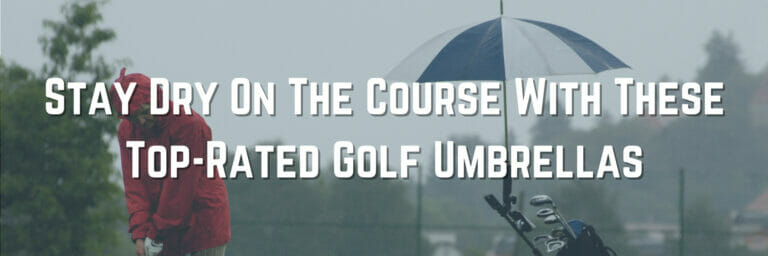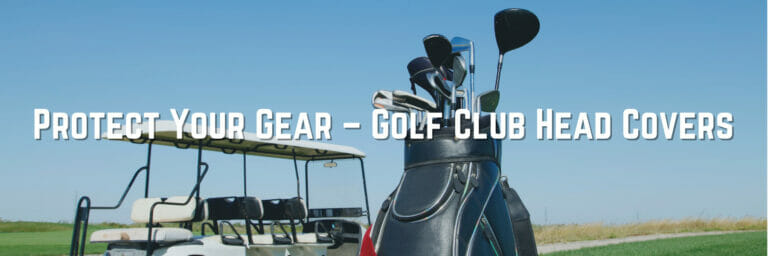The Best Sun Protection On The Golf Course

!!!!DISCLAIMER!!!! This site may contain Amazon & other affiliate links.
This means if you click on one of the product recommendation links, this site may receive a small commission. This is at no extra cost to you and may include exclusive discounts when possible. This helps support this site and allows us to keep making content like this. Thank you for your support!
The best sun protection on the golf course is a broad-spectrum sunscreen with a high SPF level (a minimum of SPF 30). Since golf season is fast approaching, here are some simple tips to keep your golfer’s skin safe and healthy:
- Always check the forecast for the UV index. (If the UV index is 3 or above, limit prolonged sun exposure)
- Avoid doing outdoor activities between the hours of 10 a.m. and 2 p.m.
- Wear sunscreen every day without fail (minimum of SPF 30). Apply it 15 minutes before going outside. Sunscreen should be reapplied every 2-3 hours.
- Wear UPF clothes (minimum of UPF 30), a wide-brimmed hat, and sunglasses.
- Stay hydrated!
Golfers and Sun Damage
Golfers are at an increased risk of developing several types of sun damage, including skin cancer, which has been dubbed “Golf’s Silent Killer.”
Recreational golfers may get between 3.5 and 5.4 times the amount of UV radiation exposure required to induce sunburn for every hour spent on the course. That is a significant amount of skin-damaging ultraviolet radiation. According to the American Academy of Dermatology, all of this excessive UV radiation may lead to skin cancer, which affects more than 3.5 million people in the United States every year.
Types of Sun Damage
Here’s a list of different types of sun damage you can get from being under the sun for too long too often.
Melanoma
Malignant Melanoma is the most dangerous kind of skin cancer, although being the least common. Most often, it manifests itself as a dark brown or black mole with irregular borders and a patchy appearance in shades of black/blue, red, or white with unusual coloration. If you notice any moles or lesions that appear to be out of the ordinary, consult your dermatologist.
Basal Cell Carcinoma
The most common kind of skin cancer is basal cell carcinoma. Because it develops so slowly, it seldom poses a danger to one’s life or spreads widely. The following are the most common symptoms on your skin: a pimple that won’t go, an open wound that doesn’t heal, or an area that bleeds when you wash your face. Regardless of where it appears on the skin, basal cell carcinoma may manifest itself anywhere.
Squamous Cell Carcinoma
Squamous cell carcinoma is the second most common kind of skin cancer. It is also very unusual to be life-threatening and is highly treatable if caught early enough. It is most often seen on the head, face, ears, or hands, and may vary in size from a few millimeters to a few centimeters in diameter. It may appear as a red lump or as an ulcer or sore that will not heal on its own.
Bowen Disease
Bowen disease is a kind of skin cancer that spreads through the epidermis and remains on the surface. The most typical appearance is a reddish-brown scaly or crusty plaque. Bowen disease may be surgically removed if it is correctly diagnosed by a dermatologist.
Actinic Keratosis
A condition known as actinic keratoses (AKs) is characterized by rough, scaly, red, or brown areas of skin that are the result of too much sun exposure. AKs are more common in those with fair skin and red or blonde hair, and they should be taken seriously since they have the potential to develop into skin cancer (carcinoma).
Actinic Cheilitis
Actinic cheilitis, often known as Farmer’s Lip, is a skin condition that is remarkably similar to actinic keratosis except that it affects the lower lip. Lips that are always dry and cracked, as well as the development of scaly areas, are some of the symptoms.
Melasma
Skin discoloration or darkening on the forehead, cheeks, nose, chin, or upper lip is called melasma (or chloasma). When melasma appears on both sides of the face, it is usually consistent and symmetrical. A woman’s melasma might be exacerbated or worsened during pregnancy because to the fluctuations in her hormones.
In order to avoid worsening melasma, people with the disease should wear sun protection that is appropriate for their skin. Treatments for melasma include topical whitening creams, chemical peels, and microdermabrasion if the condition is severe enough.
Sun Burns
It is a thermal burn on the outer layer of skin caused by prolonged exposure to ultraviolet (UV) radiation, known as sunburn. In its milder version, a first-degree sunburn is characterized by reddening skin that hurts when touched. Blistering and tissue damage may occur with second-degree sunburns. The risk of acquiring melanoma later in life is greatly increased if you get sunburn as a kid or adolescent. If you get skin blisters as a result of a sunburn, you should always seek medical attention.
Age Spots
Age spots, also known as sun spots or solar lentinges, are flat brown patches that form when the skin is repeatedly exposed to ultraviolet (UV) radiation. It is typical for age spots to appear on the face and other parts of the body that are regularly exposed to the sun. Skin lightening products, chemical peels, laser treatments, and microdermabrasion are just a few of the therapy options available to those with age spots.
Sun Tan
Sun Tan is the darkening of the skin that occurs as a result of exposure to the sun. Generally speaking, a suntan that develops immediately after exposure is mostly due to UVA exposure, while a tan that develops days after exposure is primarily due to UVB exposure. Sun exposure causes skin to darken as a result of molecular changes that take place in the skin. While certain skin types are more susceptible to the sun than others, there is no such thing as a “good tan”.
Freckles
Freckles are little, brown or beige speckles that are flat or circular in shape. They are generally very tiny. They often appear in clusters on parts of the body that are exposed to the sun on a frequent basis, such as the face and forearms. During the summer months, when UV exposure is at its peak, many individuals discover that their freckles have darkened. There are a variety of options available for reducing the appearance of freckles, including topical treatments and laser skin resurfacing procedures.
Not Just Your Average Golfer
Even professional golfers are not exempt from this problem. Adam Scott, Rory Sabbatini, and Aron Price, all pros of the PGA Tour, have battled skin cancer in the past. Sabbatini had surgery to remove a squamous cell carcinoma from his face. Scott was diagnosed with basal cell carcinoma, which is non-melanoma skin cancer. Price had three battles with non-melanoma cancer before being diagnosed with melanoma in 2010. Melanoma is the most dangerous of all skin cancers and is one of the leading causes of death in the United States.
These examples demonstrate that skin cancer is a genuine threat when you spend a significant amount of time participating in outdoor activities. And it isn’t only golfers who are affected. Tennis and soccer players, as well as anybody who enjoys spending time on a jet ski or boat, are all at risk.
There are factors that increase the risk for skin cancer, including having a family history of the disease, having light skin that gets sunburns easily, and having plenty of moles. Men above the age of 40 are at increased risk of contracting this disease. While extended sun exposure is a substantial major risk, unprotected sun exposure is a much more significant risk factor. Some golfers wear hats and sunglasses to shield their eyes and faces from the sun, but their arms, legs, and neck are often exposed as a result of their being on the course.
Sun Protection On The Golf Course
Most golfers look forward to a beautiful day on the course, completely unaware of the amount of sun damage that may occur during those 4-5 hours in direct sunlight.
Golfers and anyone who spend a lot of time outside need to be aware of the dangers of the sun.
Reflective surfaces like ponds and sand traps on the golf course enhance the strength of the sun’s beams. People who participate in water activities have the same problem. It’s possible to become sunburned when riding a jet ski, for example, without even realizing it!
When it comes to protecting your skin from cumulative UV sun exposure while playing golf, here are several things you can do:
Early Bird Doesn’t Get Sun Burned
Make a habit of getting up early in order to acquire an early tee time. Rather of bemoaning the fact that you have to get up and leave the door, touch that smooth baby face with both hands and express gratitude for being a responsible and healthy human being. If you are unable to get an early tee time, try to secure one later in the day. From ten o’clock in the morning until four o’clock in the afternoon, the sun is at its most harmful to the skin.
Don’t Burn, Baby! Don’t Burn.
Sunburn is the most common cause of the most serious skin malignancies. Always use sunscreen, 15 minutes before you leave the house and reapply it every 2-3 hours, if possible. Yes, we understand that reapplying is the most difficult to turn into a habit. That’s why for reapplication purposes, we suggest you use a sunscreen stick!
Yes, we understand that reapplying is the most difficult to turn into a habit. That’s why for reapplication purposes, we suggest you use a sunscreen stick!
Sunscreen sticks are less messy, easier to apply, carry, and won’t interfere with your golf grip!
They’re perfect for reapplying sunscreen to the face, neck, ears, and arms while on the golf course to prevent the greasy feel that regular sunscreen might cause.
Sunscreen containing zinc oxide are considered to be the most effective, yet some individuals are reluctant to use them since it makes you look like you’re ready for Halloween with that super white overcast that’s left on your skin.
But nowadays there are a variety of sunscreens that no longer leave you looking like a ghost. Don’t forget to bring a high SPF lip balm with you as well.
- (LINK TO SUNSCREEN ARTICLE)
Wear UPF Golf Apparel
There is no way to completely shield yourself from the sun’s rays, but there are precautions you may take in addition to using sunscreen.
When it comes to sun protection, clothing is your first line of defense. For the most protection, long sleeves and long pants are the best choice for clothing. There are several brands that provide golf-specific sun protection apparel, making it simple to choose items that are both lightweight and suitable for use on the course.
Clothing is given a UPF (ultraviolet protection factor) rating based on how well it blocks UV rays. UPF 5 means that only about one-fifth of the sun’s UV radiation reaches the skin through a typical cotton T-shirt. Golf clothing with a UPF 30 or UPF 50 rating provides the greatest protection from the sun’s harmful rays.
- (LINK TO UPF GOLF APPAREL ARTICLE)
Golf Hats
Wear a hat with a wide brim to protect your ears and neck. Golf umbrellas may also be used, although golf hats are preferred since they allow you to keep both hands free. Sun Visors are okay too, but your whole scalp is exposed to the sun.
While a wide-brimmed hat is normally recommended for optimal sun protection, we understand that this isn’t always the most practical choice on the golf course. Baseball hats, on the other hand, are wonderful selections since they remain in place and hide your face. Because your ears and neck are still exposed, use sunscreen to protect them.
Golf Sunglasses
Not only do they provide skin protection, but they also increase sight by reducing glare. Choose a pair that will block 99-100 percent of UV rays, so protecting the eye, eyelid, and surrounding regions when purchasing a pair of sunglasses.
Make certain that your sunglasses are of great quality, and that the optimum style is a wraparound. Some golfers are adamant about not wearing sunglasses on the course. The sun is not only harmful to the skin, but it is also harmful to the eyes. Take good care of those priceless eyes of yours, please.
Go And Be Shady
If your cart partner does not know how to find shaded parking locations for the cart, you should take up the driving duties yourself. With the introduction of golf GPS watches, it is no longer necessary to position your golf cart exactly where your ball is located on the course.
If there are no trees to provide shade, position your cart at an angle that will shield the passengers. If your cart is pointing back toward the tee box rather than forward toward the green, you may think you’re being funny, but being stupid is a minor price to pay for keeping your skin safe.
Get Annual Skin Checks
The importance of skin checks cannot be overstated for golfers and anybody who is exposed to the sun for long periods of time. Make an appointment for a skin check at least once a year to aid in the detection of skin cancers and pre-skin cancers.
Final Thoughts
In many cases, golfers are unaware of the relationship between the sport and skin cancer, as well as the amount of UV damage that accumulates on the course. Skin cancer prevention should be promoted via golf publications, golf courses, and golf clubs, among other venues. Melanoma is on the increase, and regrettably, males are more likely than women to be affected. Men under the age of 49 have a greater risk of having melanoma than any other kind of cancer.
If you’re planning to play a round of golf, ensure sure your skin is adequately protected from the sun’s harmful rays!
Frequently Asked Questions
Is it necessary for golfers to use sunscreen?
YES, YES, YES! We cannot stress this enough.
The reason why we say this is because sun exposure causes skin cancer. It also damages your eyesight, making it harder to see the ball. And the worst part? It all starts with a tan line. So, yes, sunscreen is essential for golfers.
It is important for golfers to use sun protection when they play outside. Sunscreen with a minimum of SPF 30 should be applied at least 15-30 minutes prior to going outside and reapplied regularly throughout the day. Golfers need to protect themselves from getting burned, especially when they are exposed to direct sunlight for long periods of time.
The reason why we say this is because sun exposure causes skin cancer. It also damages your eyesight, making it harder to see the ball. And the worst part? It all starts with a tan line. So, yes, sunscreen is essential for golfers.
What are the sun protection guidelines for the golf course?
In general, even on overcast days, the FDA advises that you apply a broad-spectrum sunscreen with an SPF of 30 or higher.
- Always check the UV forecast before heading outside. Avoid extended exposure to the sun if the UV index is 3 or higher.)
- It is best to stay inside between the hours of ten in the morning and two in the afternoon while the sun is the most harmful.
- Don’t forget to put on sunscreen every day! (minimum of SPF 30). You should put it on 15 minutes before you walk outdoors.
- Reapplying sunscreen every two to three hours is recommended.
- Don’t forget to protect yourself from the sun with UPF-rated clothing, a wide-brimmed hat, and a pair of sunglasses.
- Hydration is key. Don’t forget to take your water bottle with you at all times. (LINK TO WATER BOTTLE ARTICLE)
How can I maximize my sun protection while playing golf?
When playing golf, wear sunscreen and protect yourself from getting burned. If you do get burnt, apply aloe vera gel immediately after applying sunscreen. Also, wear sunglasses when the sun gets too bright.
Also, use a ball marker to mark where you hit the balls and where they land. This way you won’t have to wander around under the sun to know exactly where the balls landed and how far away they were from the hole.
What does UPF in golf clothing mean?
The UPF (Ultraviolet Protection Factor) rating system for clothes is a little different from the SPF system.
In terms of time spent in the sun without burning, SPF is a useful metric. An SPF 30 sunscreen, for example, may potentially keep you safe from burning for 600 minutes (or 10 hours) if you ordinarily get a sunburn after standing outside for 20 minutes unprotected in the sun.
UPF ratings, on the other hand, are based on the fraction amount of UV radiation that can pass through a fabric. For instance, o nly 1/50th of those UVA and UVB rays are entering through the material of a half-zip with a score of UPF 50+ (or 2 percent ).
The average UPF rating for a T-shirt is 5, which is lower than most protective clothing. A fifth of the UVA/UVB rays are getting through, or 20%!
Better protection is the result of a higher UPF rating.
For golf apparel, what is considered a good UPF rating?
In today’s world, a UPF of 30 to 49 delivers very good protection on the golf course, while a UPF of 50+ is considered exceptional.
This is how the ratings may be represented:
Good UV protection
UPF 15 or 20
Very Good UV protection
UPF 25, 30 or 35
Excellent UV protection
UPF 40, 45 or 50+





